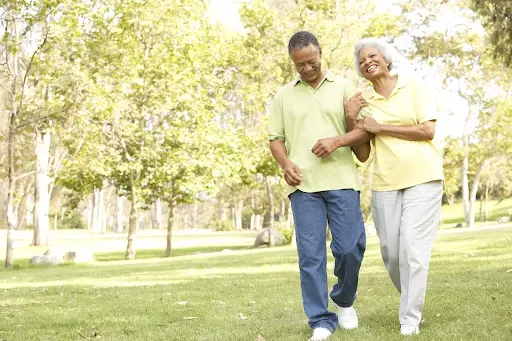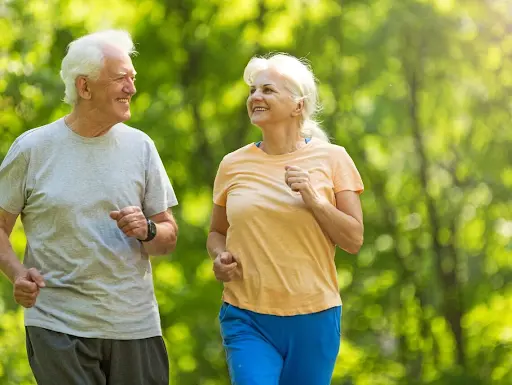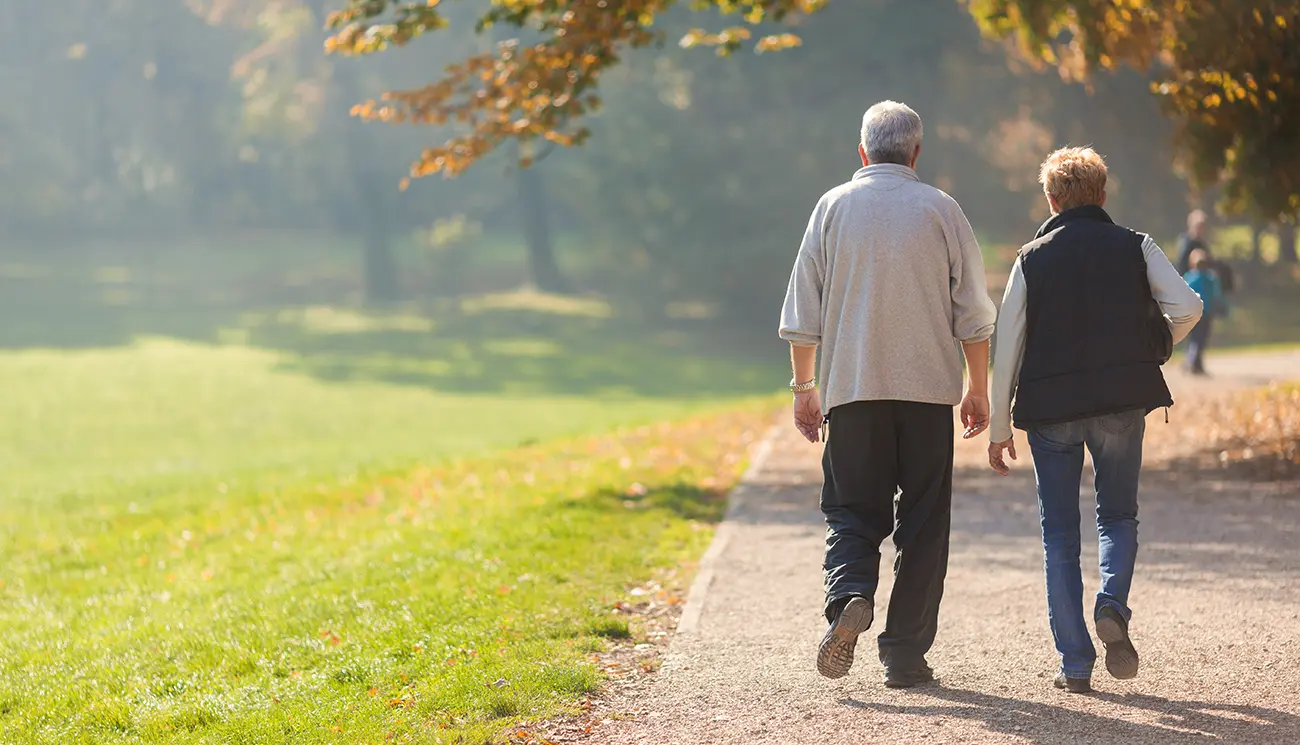Have you ever thought about how fast you walk? For most of us, this thought never crosses our mind. But current research shows that in populations older than 65, how fast you walk is really important to know. If you are a caregiver for someone 65 years old or older, it turns out that knowing how fast they walk is an excellent predictor of their life expectancy.
What is gait speed?
“Gait speed” is the medical term for how fast someone walks. Our gait speed tends to slow down as we age because our balance, coordination, strength, and cardiovascular health inevitably decline. Since those factors (balance, strength, etc.) directly impact how fast someone can walk, gait speed could be a good measure to consider when evaluating someone’s overall health and well-being.
Why does it matter?

A recent study found that how fast someone walks (down to .1 second per meter!) in addition to their age and gender, can predict someone’s life expectancy as accurately as other health indicators such as blood pressure, body mass index, chronic health conditions, etc. The fact that gait speed can accurately predict longevity is great news for family and professional caregivers alike because measuring walking speed is simple and could provide vital information about your client or loved one. Once you know the answer, you can begin incorporating various clinically proven exercises to increase gait speed into their daily lives.
How do you measure gait speed?
| Age | Average Walking Speed |
|---|---|
| (Men and Women) | (m/s) |
| 20-29 | 1.36-1.34 m/s |
| 30-39 | 1.43-1.34 m/s |
| 40-49 | 1.43-1.39 m/s |
| 50-59 | 1.43-1.31 m/s |
| 60-69 | 1.34-1.24 m/s |
| 70-79 | 1.26-1.13 m/s |
| 80-99 | 0.97-0.94 m/s |
The Center for Disease Control (CDC)’s current activity recommendations for adults 65+ are:
- 150 minutes a week of moderate intensity exercise, which includes “brisk walking”
- At least 2 days a week of muscle strengthening exercises
- Include balance activities throughout the week
Exercises to improve gait speed
Now that we know how important walking speed is, let’s take a look at different ways to improve it. Remember to always perform these exercises with someone who can help prevent any falls. Consult with a medical professional before beginning any exercise program. These exercises are simply ideas to incorporate into your daily routine to help with improving gait speed and your overall well being. Let’s dive in!

1. Walk fast for short distances
Walking fast for short distances is similar to sprints for runners. Using short bursts of intense exertion will help improve your overall exercise capacity.
2. Hold something while you walk
Holding something requires that you can’t use a countertop, railing, or assistive device like a cane while walking. This pushes you out of your comfort zone and builds confidence as well as coordination.
3. Add different directions like walking backwards or side to side
Feel free to use something for support and balance when doing this exercise because it can be very challenging. But challenging is how we get better!
4. Add a cognitive task when you’re walking
You’d be surprised how hard walking becomes when you’re trying to solve a math problem in your head! Adding a cognitive task like saying the ABCs backward or naming all of your grandchildren while walking can help improve coordination.
5. Walk to the beat of a metronome
Keeping pace with a beat is great for increasing gait speed because you are “forced” to keep stepping to stay on the beat. It’s also very simple to use because you can just Google “metronome” on your smartphone and adjust the tempo to a comfortable speed.
6. Take longer steps
This may sound simple, but taking longer steps widens your base of support when walking and this can make you feel more unstable, therefore improving your stability when walking normally.
7. Strengthen your other muscles, especially the hips
Last but definitely not least are general strengthening exercises. The stronger you are, the more stable you will be. Simple exercises like “sit to stands” (sitting down and standing back up over and over) can improve leg strength as well as cardiovascular endurance. This exercise is also simple to modify. If you need a little support, use your hands to push up on the arm rests of your chair or perform the exercise in front of a countertop for support.
For elderly adults, how fast they walk is a great indicator of their overall health because walking requires balance, coordination, strength, and endurance. Measuring gait speed is a simple process that anyone can do with a few items around the house, and the result can be an invaluable resource. We all need consistent exercise regularly; your senior loved one or client is no different. The CDC recommends 150 minutes a week of moderately intense exercise for adults 65 and older. All of the exercises explained above are ways to improve gait speed in particular.
How can Silverleaf Eldercare help?
Silverleaf Eldercare is dedicated to helping your loved one thrive. Some of the ways they help keep your family member active are: a full-time activities director to plan and lead regular activities with other members of the community, a low staff-to-resident ratio (1:6) that allows time for individualized and undivided care, as well as partnerships with local home health companies to provide speech, occupational, and physical therapy to qualifying residents. The staff at Silverleaf value time outdoors and understand the importance of daily exercise so one-on-one walks are incorporated into each resident’s daily schedule and tailored to their unique mobility needs. Silverleaf Eldercare also uses LifeLoop technology to maximize residents’ program and community engagement by tailoring activities to the individual. Residents in facilities using the LifeLoop platform report 33% reduction in loneliness on average.
To find out more about how our unique senior residential care community can meet your and your loved one’s needs, get in touch today to schedule a visit.
Disclaimer: The statements on this blog are not intended to diagnose, treat, cure or prevent any disease. The author does not in any way guarantee or warrant the accuracy, completeness, or usefulness of any message and will not be held responsible for the content of any message. Always consult your personal physician for specific medical advice.
Citations
Centers for Disease Control and Prevention. (2023, April 13). How much physical activity do older adults need?. Centers for Disease Control and Prevention. https://www.cdc.gov/physicalactivity/basics/older_adults/index.htm
Elderly man and woman walking arm in arm. (2016). asccare.com. Retrieved July 11, 2023, from https://www.asccare.com/walking-beneficial-seniors/.
Studenski, S., Perera, S., Patel, K., Rosano, C., Faulkner, K., Inzitari, M., Brach, J., Chandler, J., Cawthon, P., Connor, E. B., Nevitt, M., Visser, M., Kritchevsky, S., Badinelli, S., Harris, T.,
Newman, A. B., Cauley, J., Ferrucci, L., & Guralnik, J. (2011, January 5). Gait speed and survival in older adults. JAMA. https://www.ncbi.nlm.nih.gov/pmc/articles/PMC3080184/
Thomas, J. (n.d.). Two elderly adults walking. sonashomehealth.com. Retrieved July 11, 2023, from https://www.sonashomehealth.com/the-importance-of-exercise-for-seniors/.
Usa, H. (2022, November 29). How to improve walking speed in seniors. HUR USA – FOR LIFELONG STRENGTH. https://hurusa.com/how-to-improve-walking-speed-in-seniors/
10 metre walk test. Physiopedia. (n.d.). https://www.physio-pedia.com/10_Metre_Walk_Test

